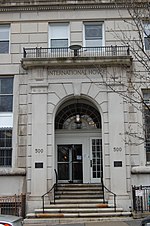Baylander (IX-514)
1968 shipsAircraft carriers of the United States NavyHelicopter carriersShips built in CaliforniaTraining ships of the United States Navy ... and 2 more
Unclassified miscellaneous vessels of the United States NavyVietnam War auxiliary ships of the United States

Baylander (IX-514), ex-YFU-79, was a United States Navy Helicopter Landing Trainer (HLT), billed as the world's smallest aircraft carrier. It served as a practice landing site for helicopter pilots in the United States Navy, Army, Air Force, Marine Corps, Coast Guard, and National Guard.
Excerpt from the Wikipedia article Baylander (IX-514) (License: CC BY-SA 3.0, Authors, Images).Baylander (IX-514)
Riverside Walk, New York Manhattan
Geographical coordinates (GPS) Address Website Nearby Places Show on map
Geographical coordinates (GPS)
| Latitude | Longitude |
|---|---|
| N 40.819171 ° | E -73.962104 ° |
Address
Baylander Steel Beach
Riverside Walk
10115 New York, Manhattan
New York, United States
Open on Google Maps










